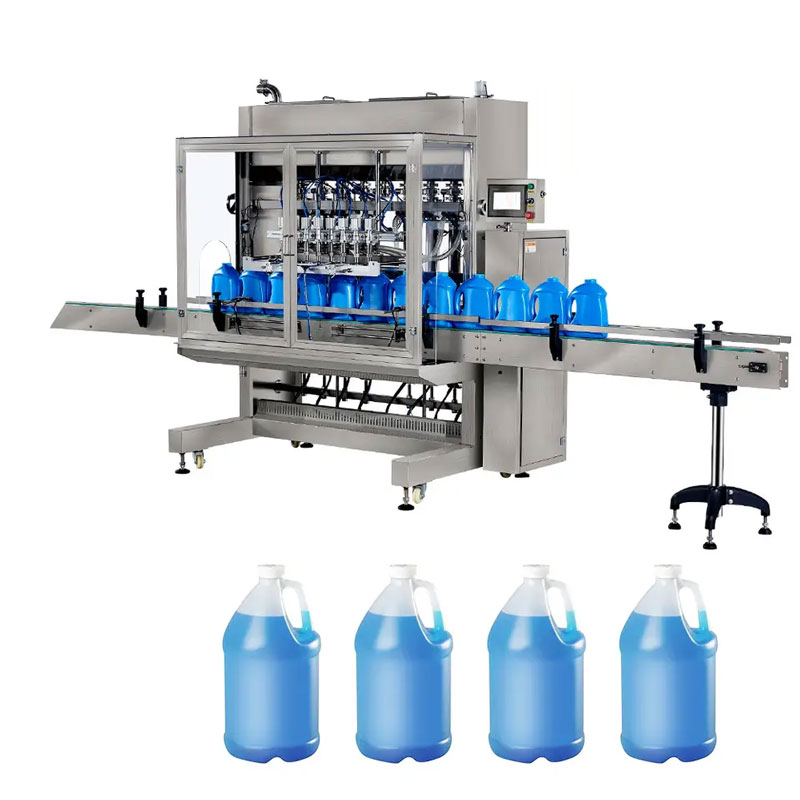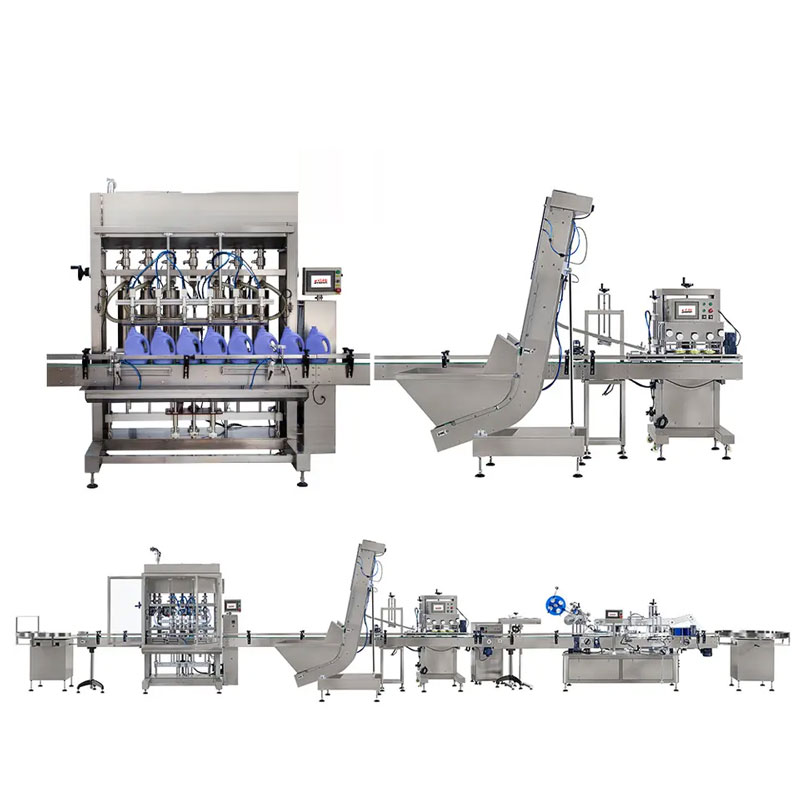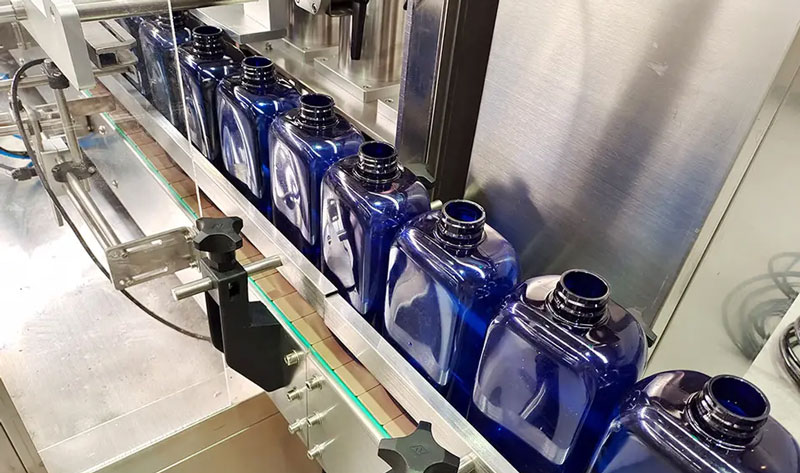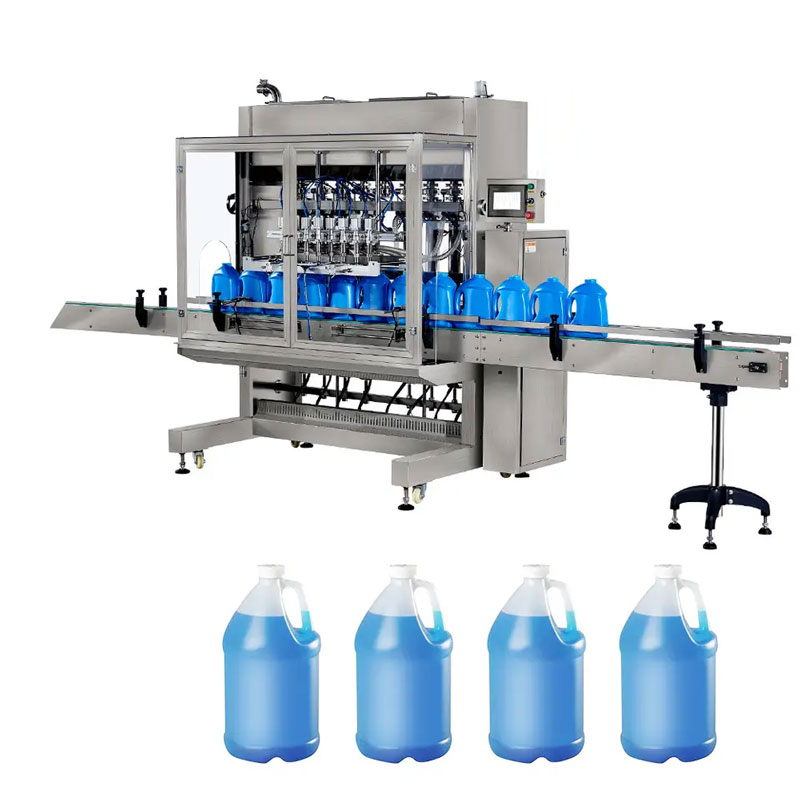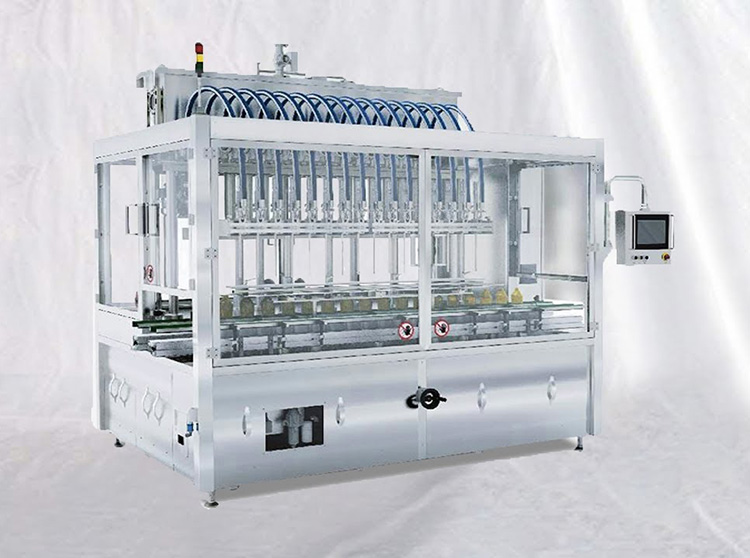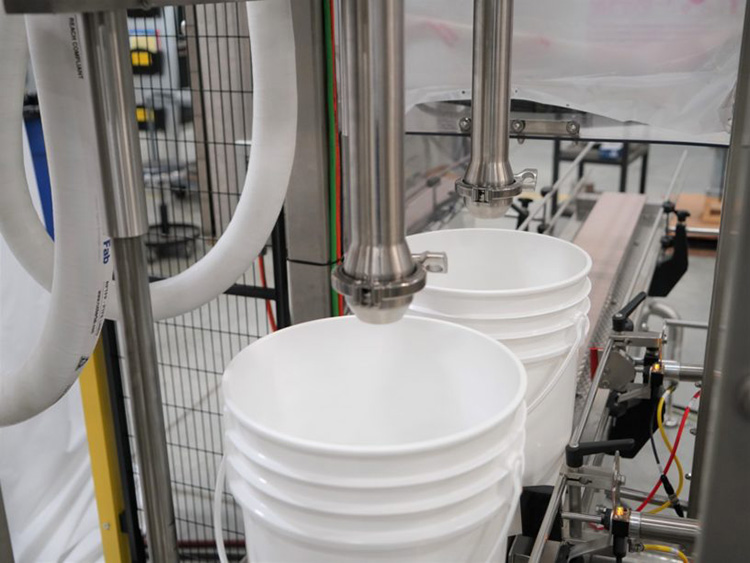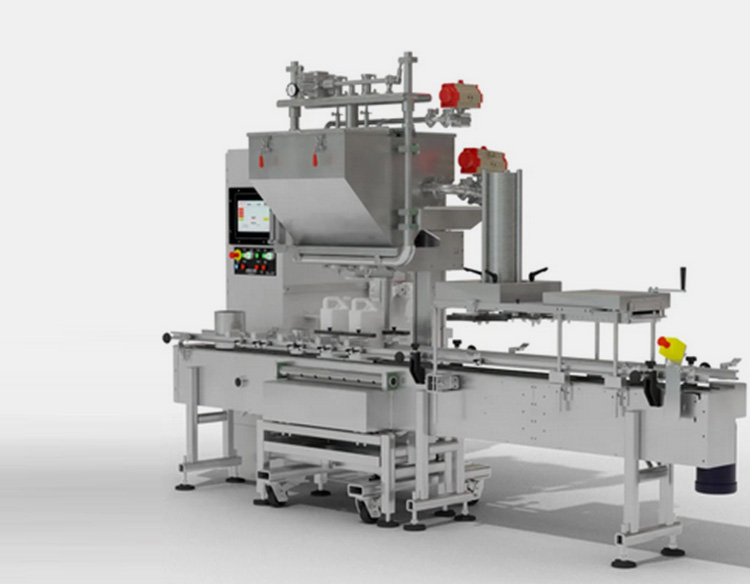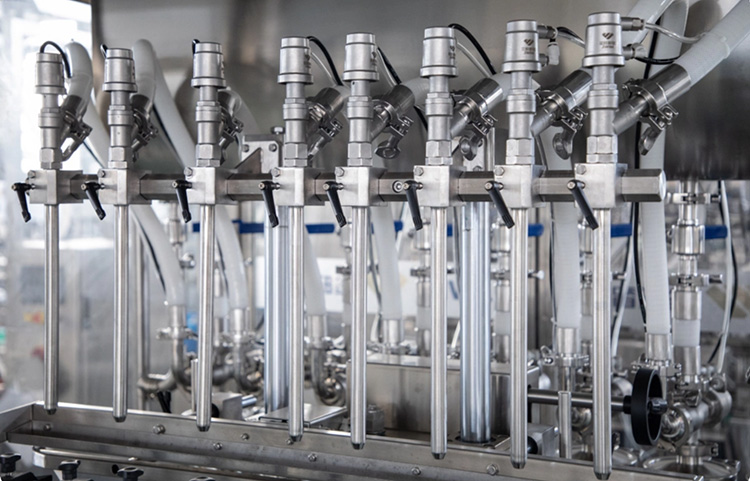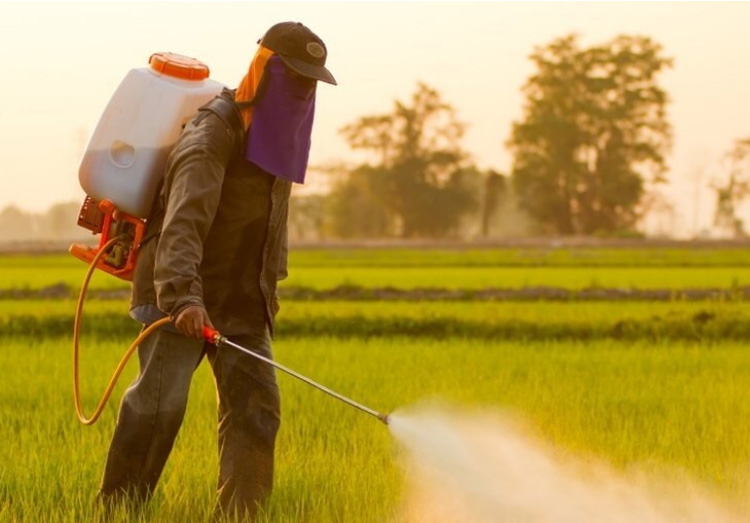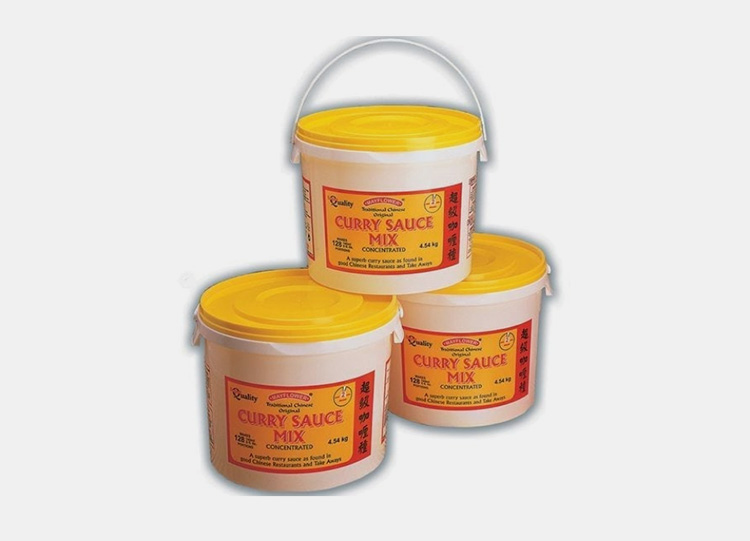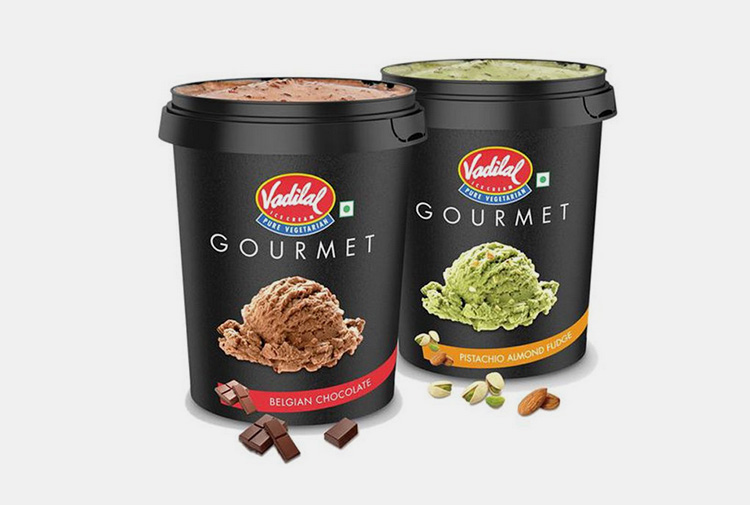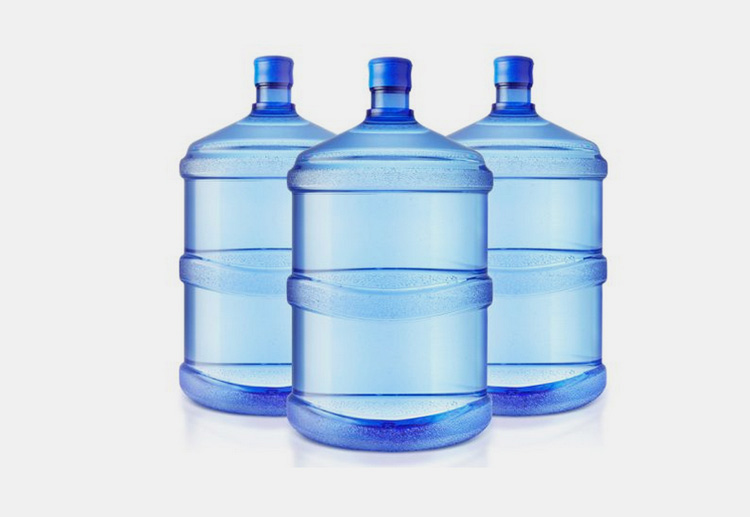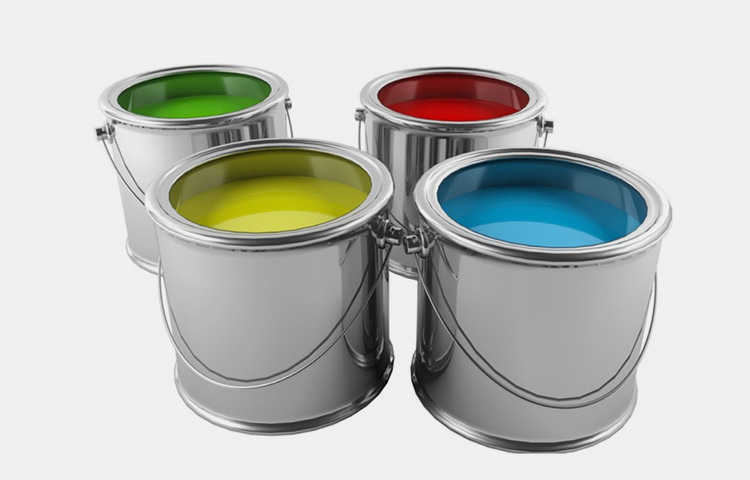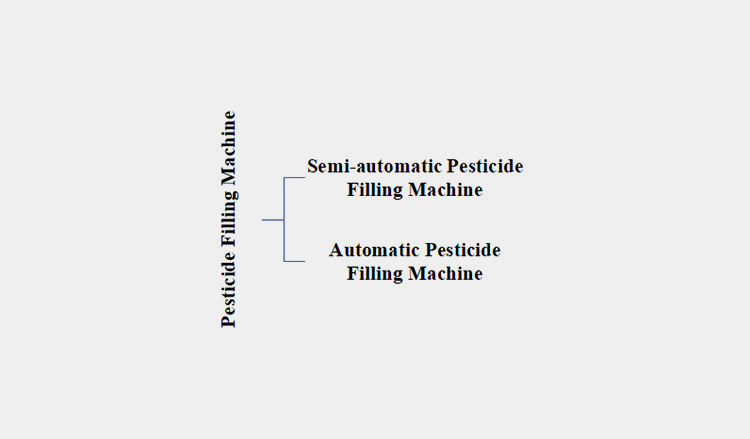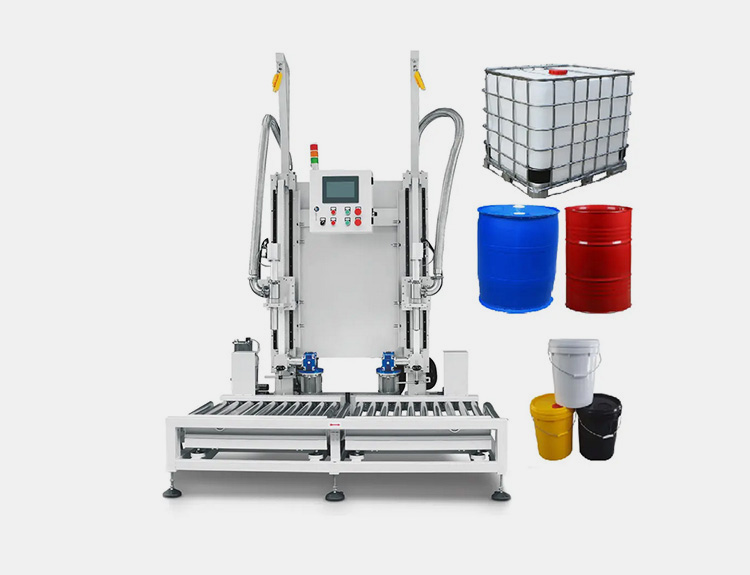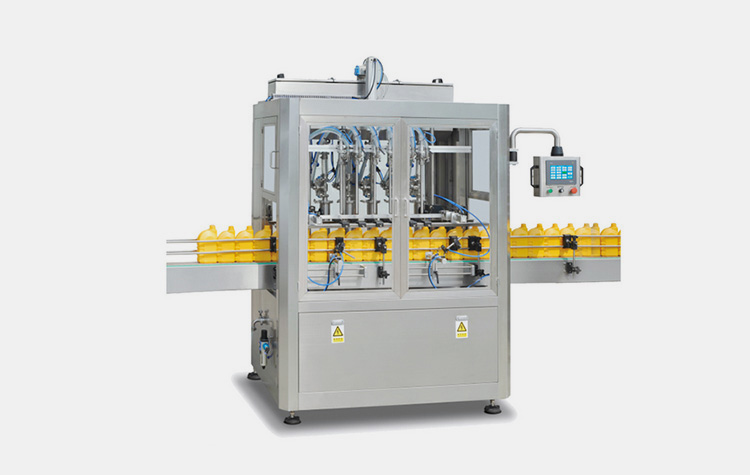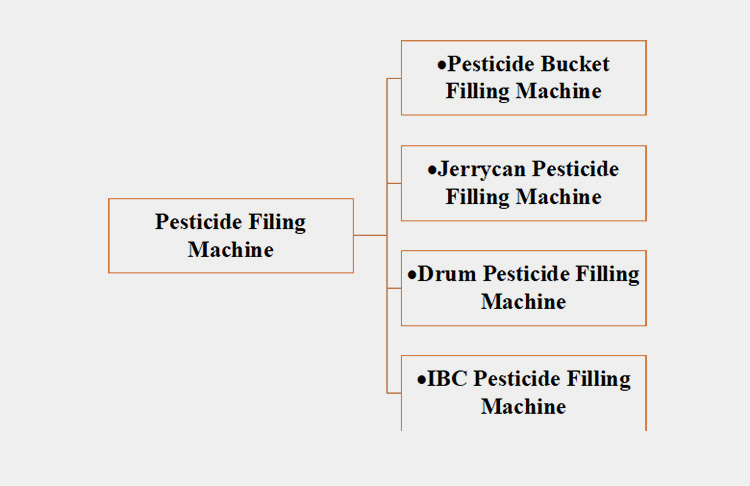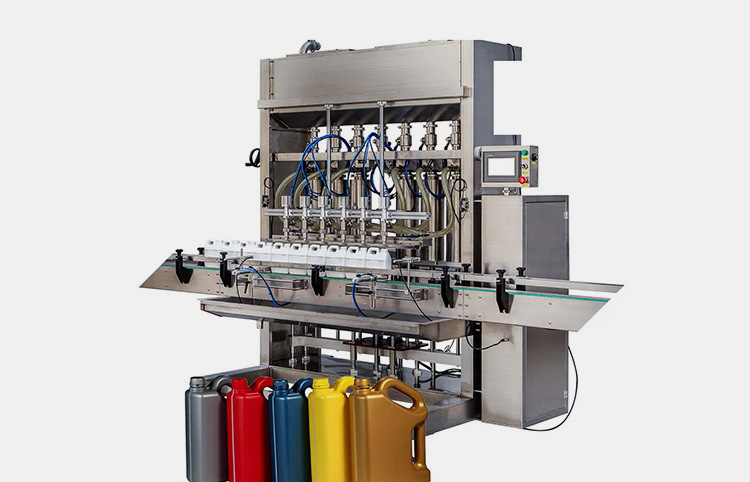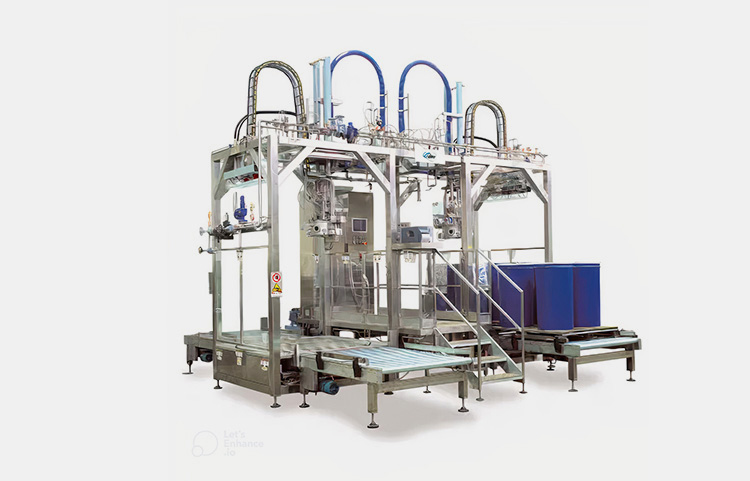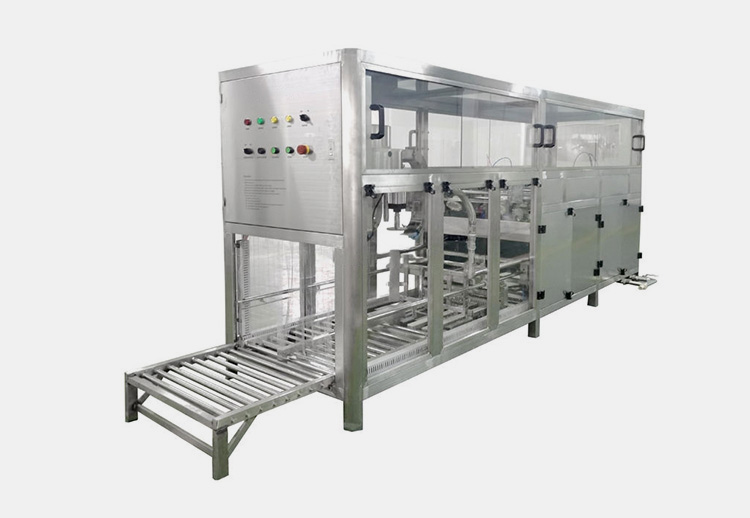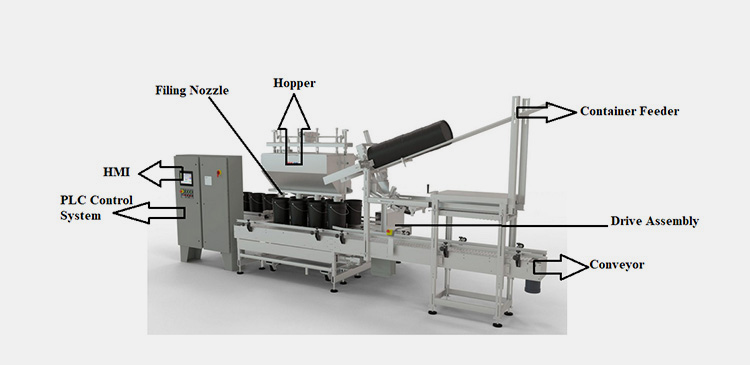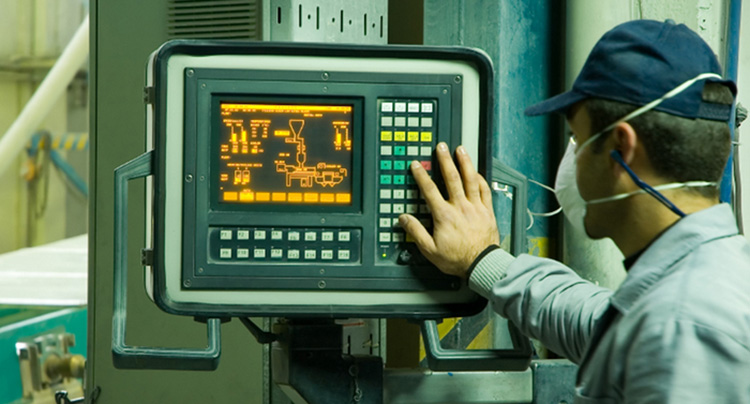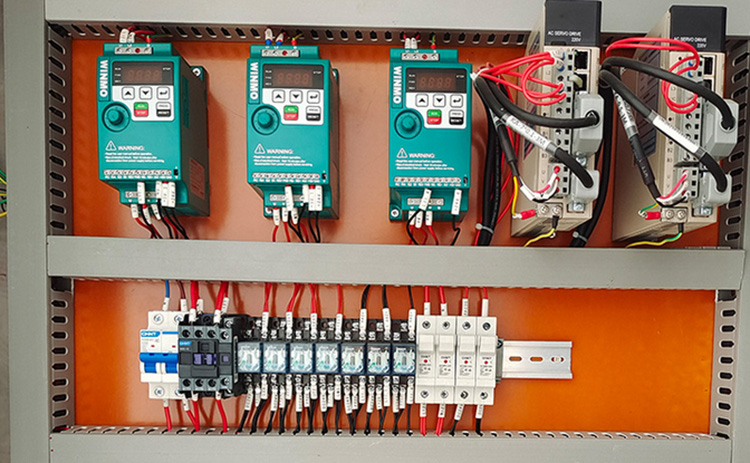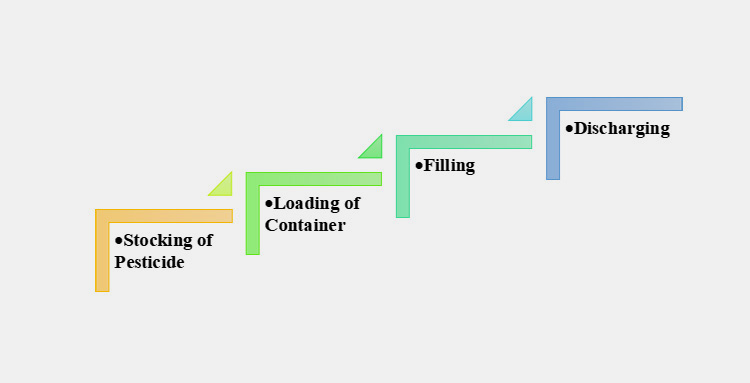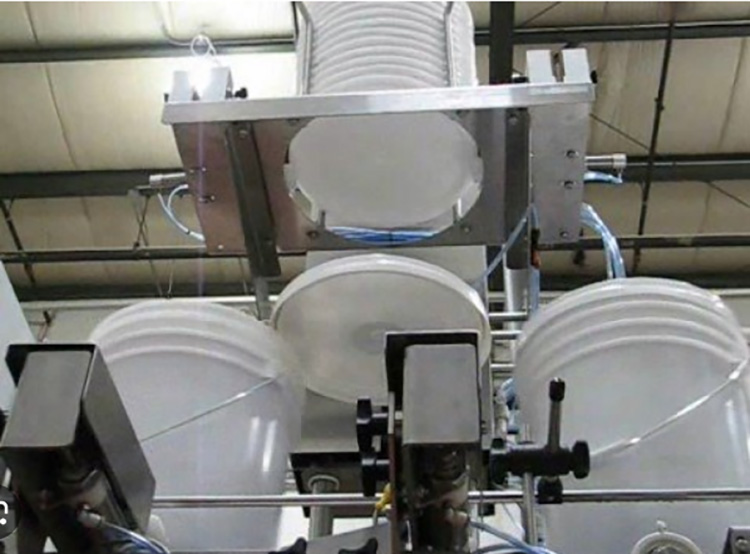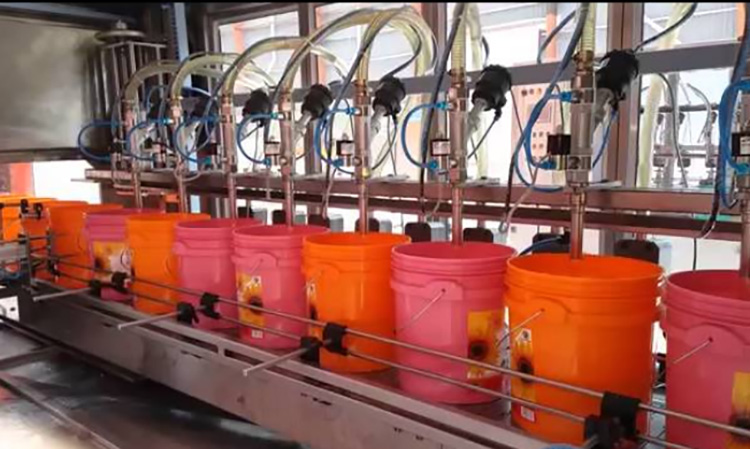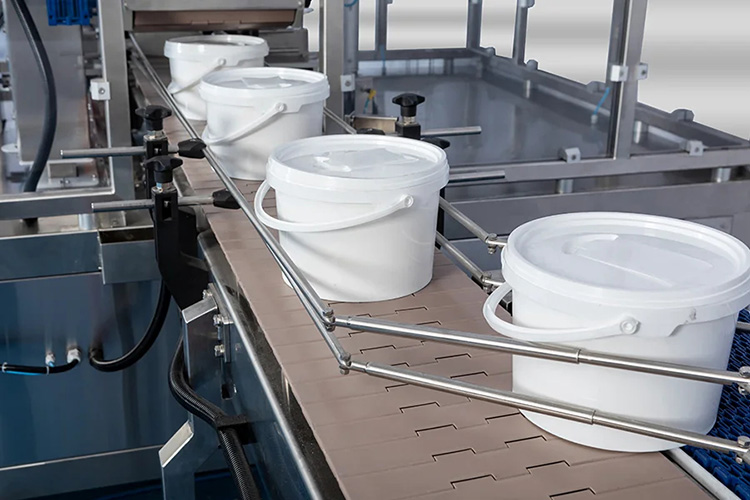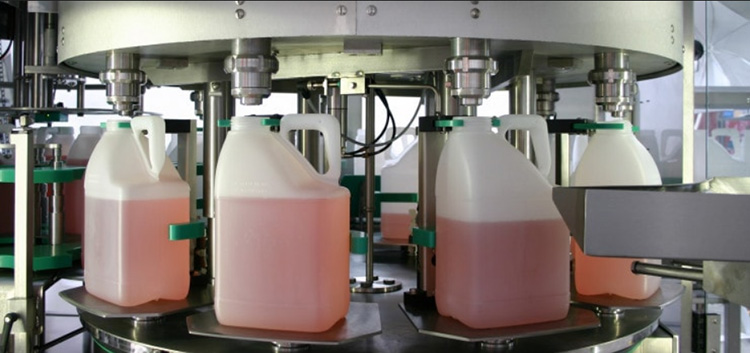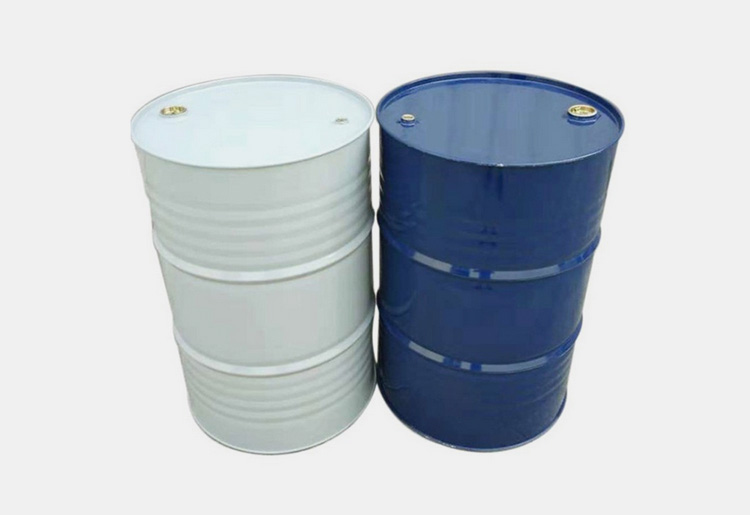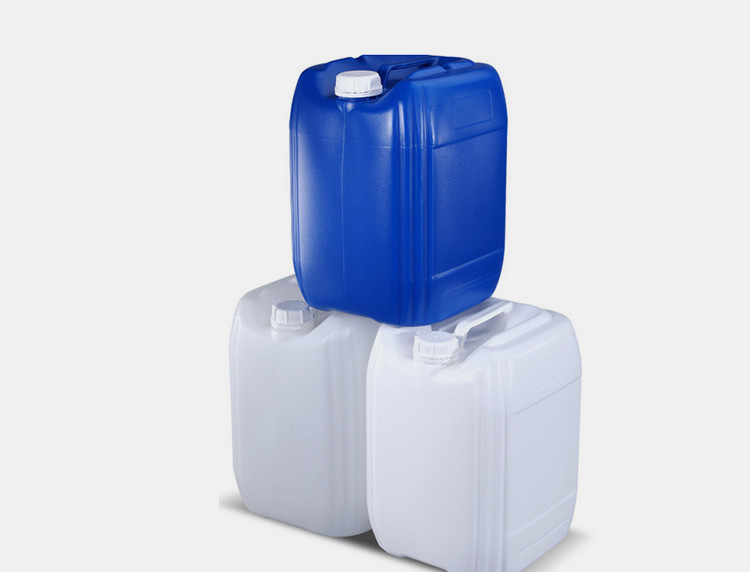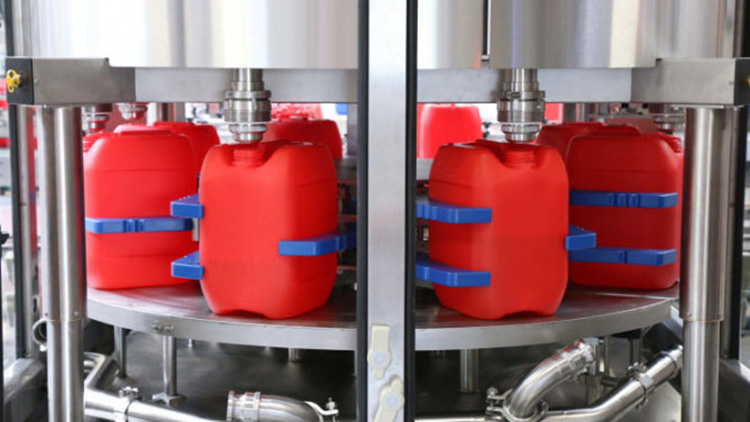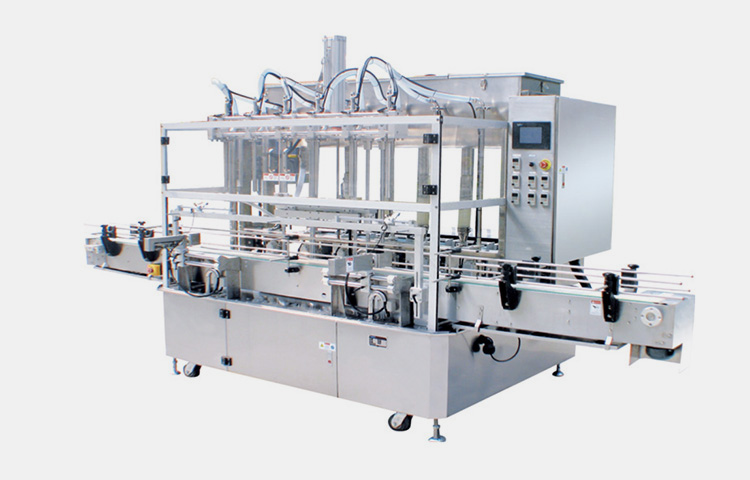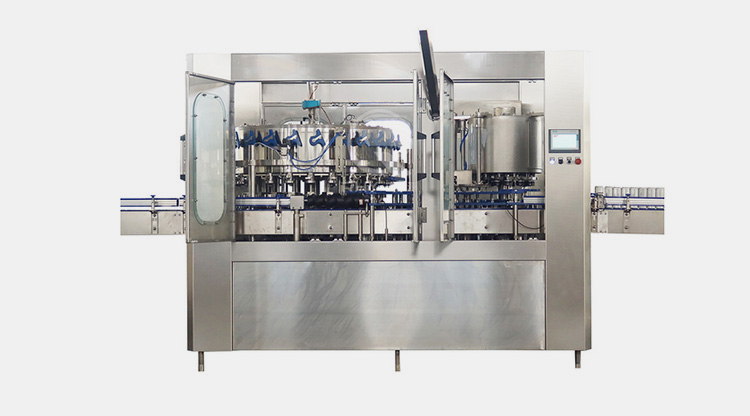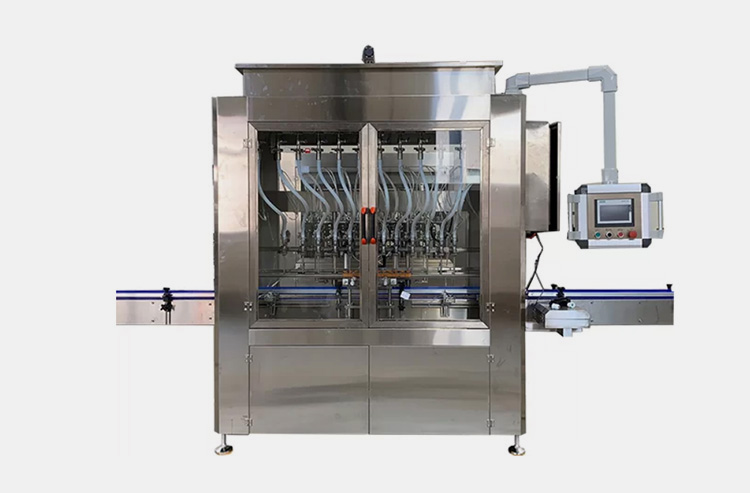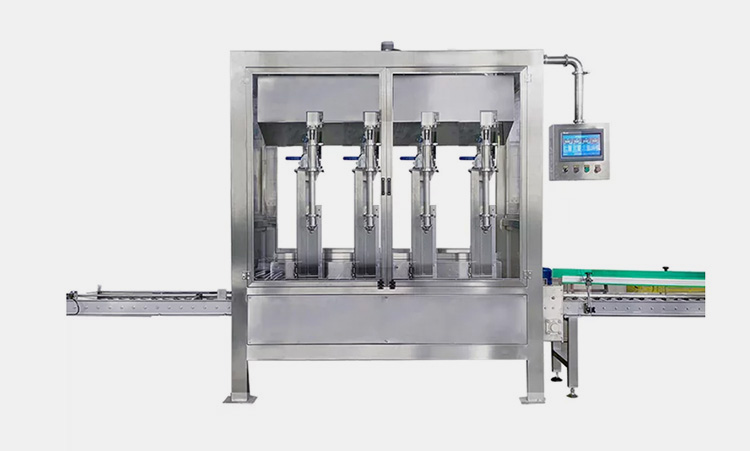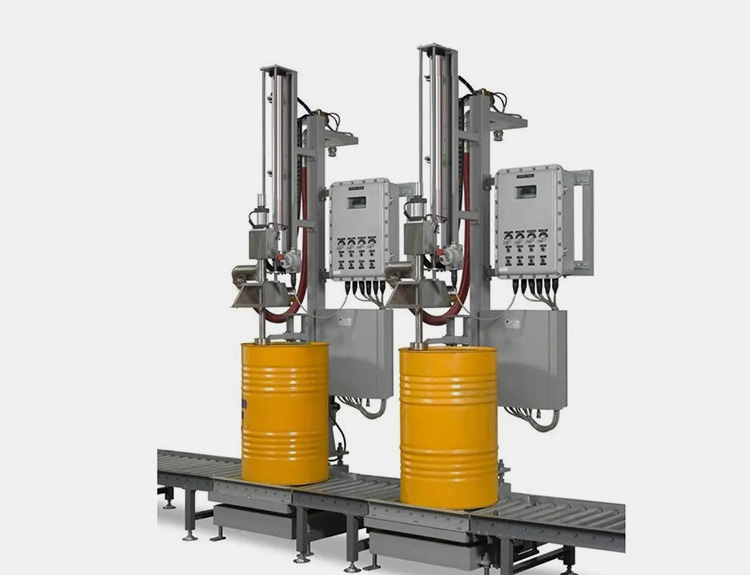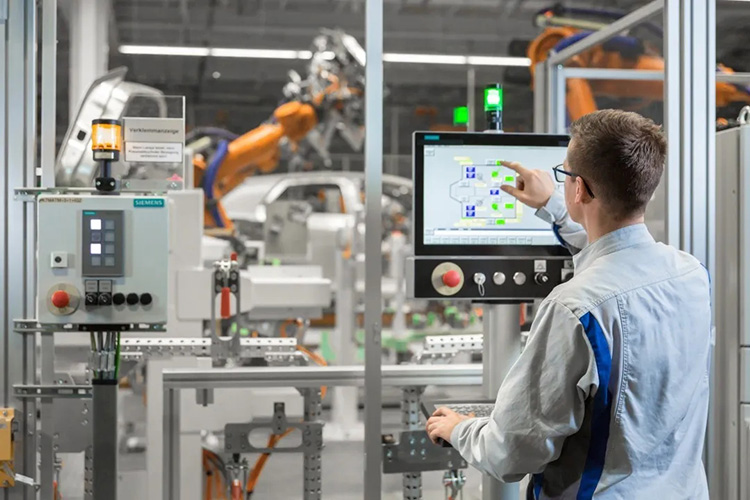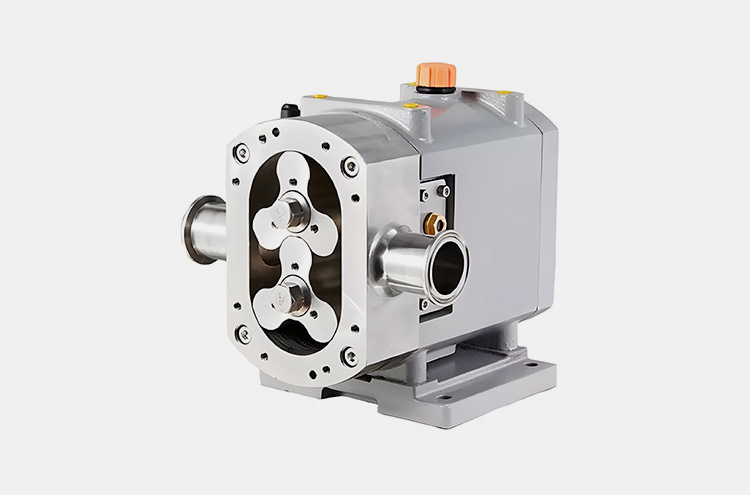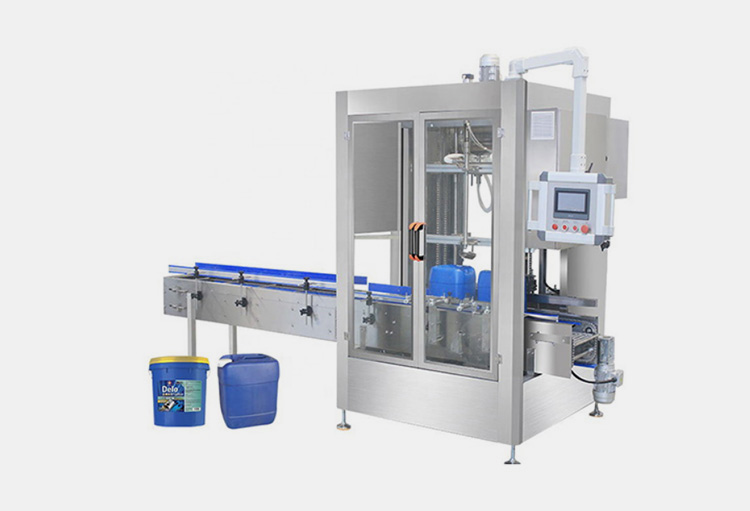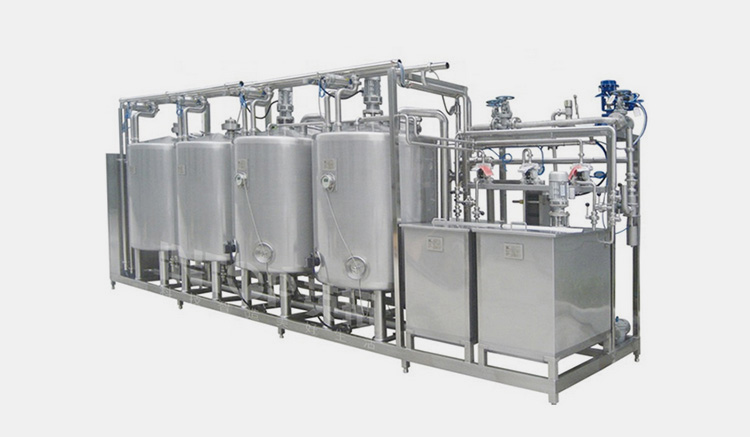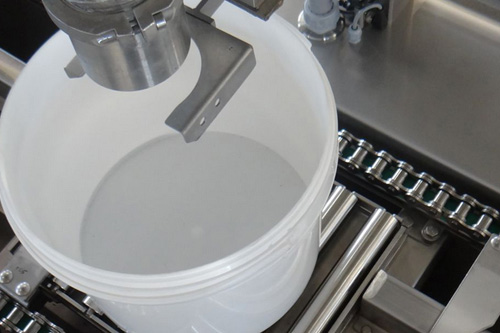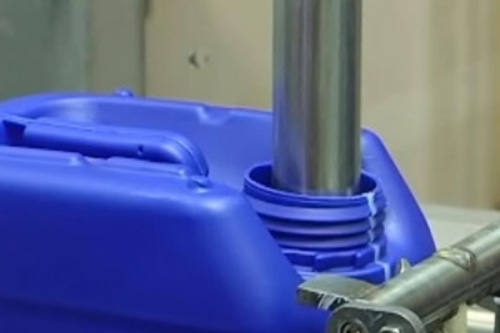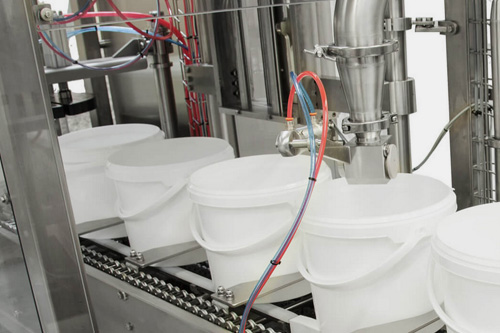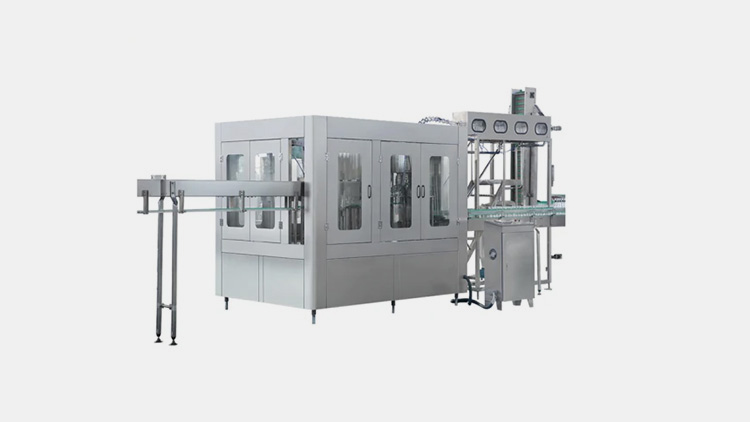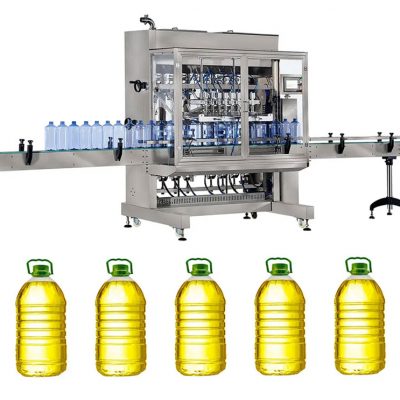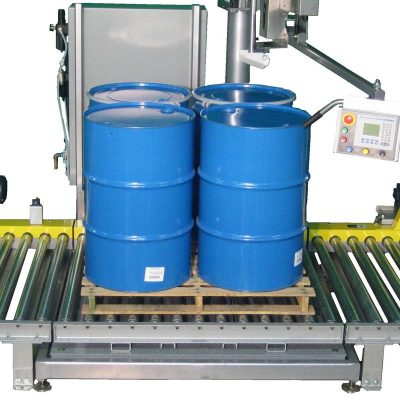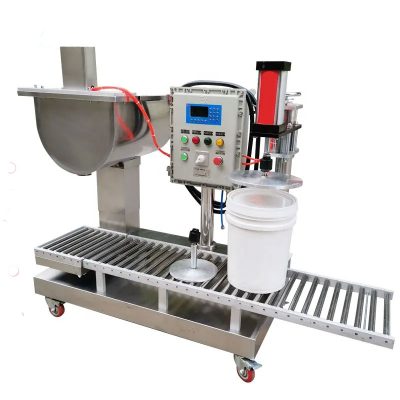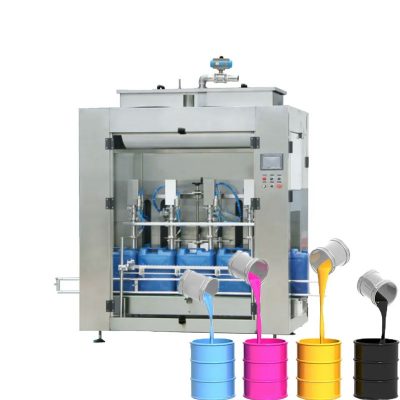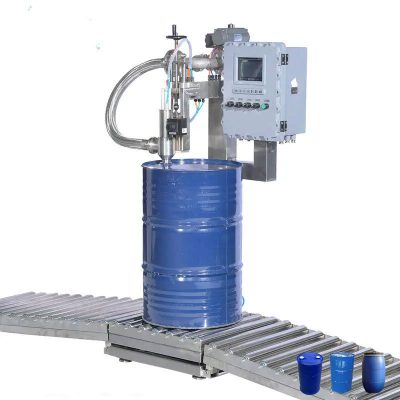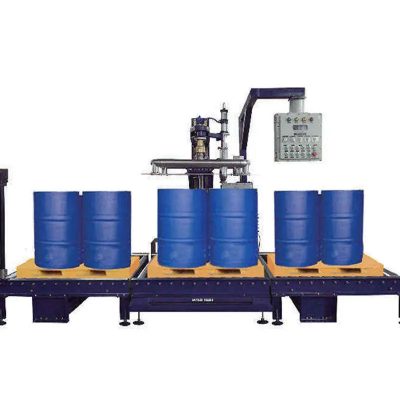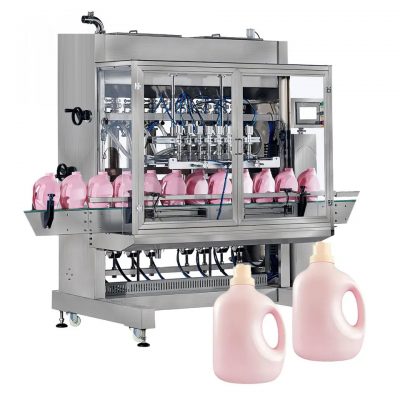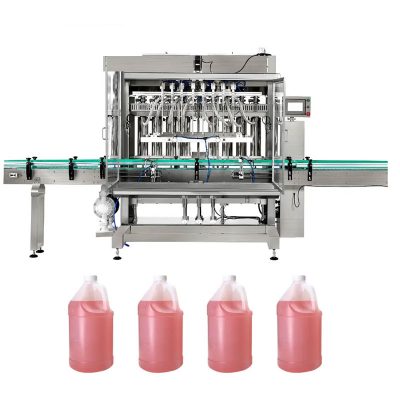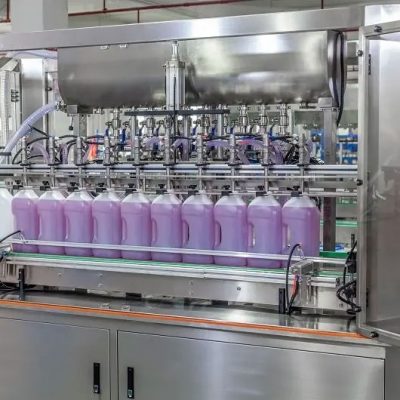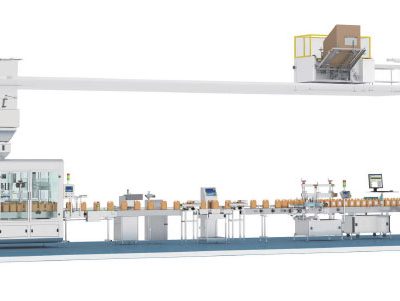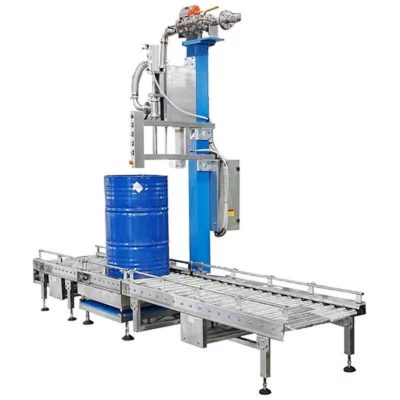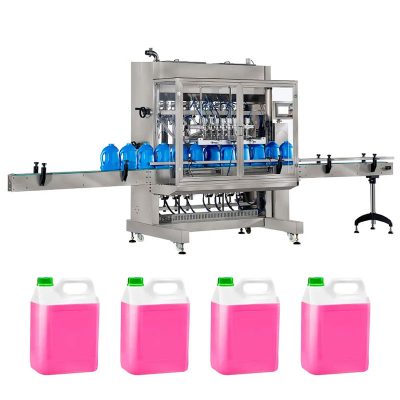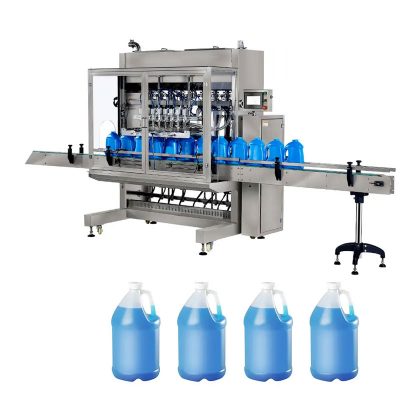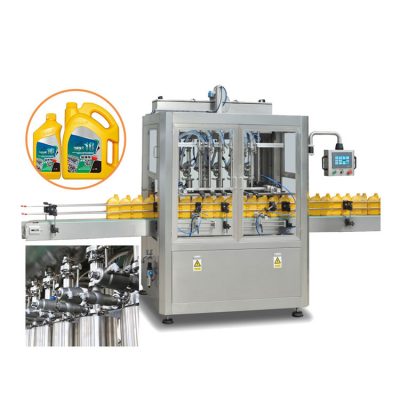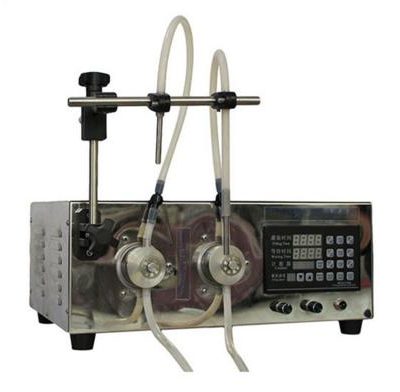Pesticide Filling Machine Chlorine Disinfection Alcohol Bottle Filling Automatic liquid filling line

Allpack pesticide filling machine automatic liquid filling line can be also called automatic acid filling machine,is often used for filling free-flowing,non foaming,non flammable chemicals because of low relative capital cost and flexibility of container size and geometry.This pesticide filling machine also can be used to efficiently fill both containers with small openings as well as large bulk containers with large openings.However,if the product is foamy,this pesticide filling machine may not be as efficient as the overflow filling for filling containers especially with small openings.
The pesticide filling machine is a full corrosion-protecting high-tech filler integrating in the PLC program control, photo electricity transuding and pneumatic. The machine is specially used in the liquid filling of strongly corrosion liquid and cosmetics which can’t touch the metal. The equipment’s all parts touching liquid are manufactured with the non-metallic corrosion protection material, and designed the descending filling function. Measurement accurate, there is not bubble and drool as filling.
Difference:
It integrates light, machine, electricity and gas into one body. Control feeding time is adopted to realize different metering and filling, the filling time can be controlled to one percent seconds. Filling process is under the control of the PLC program on the touch screen to complete. Imported brand filling valve, advanced technology, precision, filling and non drip phenomenon.
Allpack Pesticide Filling Machine Features:
1.The weighting system is from METTLER TOLEDO from Switzerland and USA, with high filling accuracy.
2.The contact parts and exposed parts of the materials are made of high quality stainless steel material SUS304 & SUS316L.
3.Each filling head has a weighing and feedback system that can fill each head. Filling for filling setup, adjustment and monitoring. Weighing sensors, proximity switches, etc. are all advanced sensing components, so that no barrels are not filled, the barrels are automatically stopped and alarmed.
4.The anti-drip and anti-drawing filling nozzles to ensure that the liquid does not draw water and drip.
5.Use PLC and human-computer touch screen control system: change specifications, filling volume adjustment, parameter setting, manual operation, etc. are evenly completed on the touch screen.
6.Photoelectric sensing and pneumatic door control, lack of bottles, inverted bottles are automatically protected.
Allpack Pesticide Filling Machine Technical Specification:
|
Filling heads
|
2
|
4
|
6
|
8
|
|
Suit to fill
|
Liquid like water or oil or semi-paste
|
|||
|
Filling range
|
5-1000L
|
|||
|
Filling method
|
Gravity+ weighing filling
|
|||
|
Filling speed
(Bottles/ hour, based on 5L)
|
5-10
|
10-20
|
20-100
|
200-1000
|
|
Filling error
|
±5g (Based on 5L)
|
|||
|
Power
|
220/380V 50/60Hz 1.5Kw (Can be tailor made to suit different countries)
|
|||
|
Air pressure
|
0.6-0.8Mpa
|
|||
|
Weight
|
400Kg
|
500Kg
|
600Kg
|
700Kg
|
|
Machine sid
( L*W*Hmm)
|
1800*1000*2200
|
2400*1000*2200
|
2800*1200*2200
|
3000*1200*2200
|
The Buyer's Guide
Pesticide Filling Machine: The Complete Buying Guide in 2024
Did you know pesticide is harmful to you and your work environment?
Preparing pesticides using safe machinery and proper handling can save you as well as the natural ecosystem. Plus, it is your responsibility to take care of your workers and the atmosphere if you belong to a reputable manufacturing firm.
Technical sciences have suggested advanced solutions to production companies by offering extraordinary equipment. A pesticide filling machine is an absolute answer that helps in the efficient filling of pesticides in respective filling packaging. Planning to invest? Indeed, a good decision! But, read this blog to find out more about the pesticide filling machine and how it can successfully run your business.
1.What is Pesticide Filling Machine?
Pesticides are substances that are used for controlling different types of pests and weeds. Pests and weeds damage livestock, crops, and other agricultural feed. Pesticide filling machines load the precise volume of liquid pesticides in different containers like pails, buckets, jerrycans, drums, or bulk shipping units.
It is a large-capacity filling machine and is useful in small farms and large agricultural plants for ease of use and pesticide transportation. Pesticide filling machines are also handy in increasing pesticide safety and decreasing health risks.
2.Why Do You Need a Pesticide Filling Machine?
A pesticide filling machine is heavily employed in the chemical and agriculture sector due to its efficient filling capacity and lower error rate. Some handy benefits that pesticide filling machine brings to your production line are:
Flexibility and Versatility
This machine fills different types of bulk containers with a variety of pesticide products. This versatile filling is possible because of simple adjustments to the machine. Moreover, this equipment also fills both viscous and thin-consistency pesticides.
No Batch-to-Batch Variation
Filling pesticides manually can lead to high variation in pesticide volumes. This results in product recall as well as loss of credibility. By using a pesticide filling machine there is little to no chance of error in pesticide filling which ensures uniformity in every batch.
High Speed
This equipment has a higher filling rate, therefore, filling more pesticide containers in a short duration. The pesticide filling machine with its automated systems goes beyond the manual filling speed.
Safety
Exposure to harsh pesticide chemicals causes skin burns and other health-related issues which are unavoidable during manual filling. However, by using a pesticide filling machine workforce is not exposed to pesticides thus this machine ensures their safety.
Long Operational Use
Pesticide filling machine is one-time investment generating profits for decades. This machine is durable, long-lasting, and capable of working extended shifts without wear and tear. With regular maintenance and cleaning, you can extend its operational life.
Scalability
One of the biggest advantages of the pesticide filling machine is its scalability. With increasing production needs you can simply upgrade this equipment without switching to a new one. You can simply install new filling heads in the pesticide filling machine to satisfy your expanding business requirements.
3.Where Can You Use a Pesticide Filling Machine?
Today, in the era of innovative packaging, pesticide filling machine is everywhere. This machine is popular in various industries due to its ease of use and versatility. Some important industrial applications of this equipment include:
Agriculture Industry
This machine has vast application in the agriculture industry for filling different kinds of agents for protecting crops such as herbicide, insect repellent, pest repellent, nematicides, anti-fungal, anti-bacterial, etc. This machine packs various kinds of liquid fertilizers.
Food Industry
In the food industry, a pesticide filling machine dispenses different kinds of pasty and viscous such as ketchup, condiments, purees, jams, and chocolate products in large pails, buckets, cans, etc. Moreover, a pesticide filling machine is highly sought after for its precise filling of vegetable oils in intermediate bulk containers.
Dairy Industry
This handy system has found its use in the packaging of dairy products like yogurt, cheese, cream as well as ice cream. A pesticide filling machine is employed for its precise dosing in both de-stackable and non-de-stackable packaging in the dairy industry.
Water Treatment Industry
One of the major applications of a pesticide filling machine is drinking water filling. This machine is equipped with various kinds of fillers and pumps for meting out a bulk volume of water in large-sized cans and bottles.
Chemical Industry
No chemical industry is complete without a pesticide filling machine. This equipment safely loads huge volumes of solvents, paints, glues, pigments, acids, disinfectants, and other household bleaches in metal buckets and cans.
Automotive Industry
This machine is routinely employed in the automotive industry for filling motor oils, anti-freeze, gasoline, petrol, paints, and cleaning agents for different kinds of vehicles.
4.What is the Main Classification of Pesticide Filling Machine?
There are different ways to classify a pesticide filling machine such as on automation level and type of container. Classification of pesticide filling machine is detailed below:
Classification Based on Automation
There are three different kinds of machines based on the level of automation.
Semi-automatic Pesticide Filling Machine
In this type of semi-automatic pesticide filling machine, loading and removing a container is performed by the operator. It has a smaller footprint and is generally suitable for small-scale businesses.
Bulk containers are loaded one by one on the small conveyors and one to two filling nozzles fill pesticides. This machine is equipped with PLC systems for accurate pesticide dispensing.
Automatic Pesticide Filling Machine
It is equipped with robotic arms or feeder devices that load the containers on the conveyors and filling and discharging are performed by the machine independently. It has four to sixteen filling nozzles to fill bulk loading of pesticides. This machine has a large footprint and is best for mass-scale production plants.
Classification Based on Container
There are four different kinds of pesticide filling machines when classified by type of container.
Pesticide Bucket Filling Machine
This machine uses different types of pumps and filling nozzles to fill large volumes of pesticide inside bucket-type containers. Pesticides are loaded inside the buckets using flowmeters, pistons, and scales.
The bucket pesticide filling machine is designed to accommodate both circular and square-shaped buckets.
Jerrycan Pesticide Filling Machine
It dispenses an accurate amount of pesticide by measuring the weight of products. Jerrycan pesticide filling machine can handle different viscosities of pesticide products. This machine is equipped with bottom-fill nozzles that reduce the chance of foaming.
A jerrycan pesticide filling machine comes in both linear and rotary filling configurations. It can dispense 5 litres to 30 litres of pesticide in jerrycans.
Drum Pesticide Filling Machine
This machine has multi-heads with about 4 to 8 nozzles for filling bulk volume of pesticide inside the drum container which aids in mass-scale transportation and shipment of pesticides. The drum pesticide filling machine is equipped with PLC controls for meting out 10 litres to 300 litres of pesticides.
It is offered with roller conveyors and usually performs the filling process by weighing and vibration.
IBC Pesticide Filling Machine
It is equipped with volume filler, gravity filler, or flowmeter filler to fill large loads of pesticide in intermediary bulk containers (IBC) for mass shipment. IBC pesticide filling machine dispenses about 60 litres to 1000 litres of pesticide.
This machine is furbished with different sensors for fast and safe filling.
5.What are the Main Parts of a Pesticide Filling Machine?
A pesticide filling machine is formed by different parts that play a significant role in precise pesticide filling. The main parts of pesticide filling machine are discussed below:
Infeed Hopper
The bulk amount of pesticide liquid is filled inside the infeed hopper at the beginning of the filling operation. It is a trough-like device that moves the pesticide liquids to the filling nozzles.
Filling Nozzle
It is also known as the filling head and is the main part of a pesticide filling machine that interact with packaging container. Filling nozzles dispense or mete out accurate amounts of pesticide in the containers.
HMI
It is an intuitive and interactive control system either a touch screen or toggle button panel. HMI has various buttons or display options for setting the parameters of operation. Moreover, it assists in supervising the entire filling operation.
PLC Control System
It is a mini-processor of a pesticide filling machine and coordinates and controls the functioning of every part of this equipment. It regulates the filling volume, speed, and movement of a conveyor system and a drive assembly. Operators interact with the PLC system via HMI for programming and adjusting filling operations.
Conveyor
It is part of a pesticide filling machine that transports the containers to the filling station and discharge unit.
Drive Assembly
It is an efficient engineering unit that has a role in an automated and controlled operating pesticide filling machine for precise meting out of pesticide. It is a timed component that ascertains the synchronicity between the filling and transport of containers. It is either of motor-driven belt design, gearbox with sprocket design, or drum-roller design.
Container Feeder Device
It is an automated system on which a large number of containers are loaded before the start of operation. A container feeder device is typically part of an automated mass-scale pesticide filling machine and places containers one by one on the conveyor systems for filling.
6.How a Pesticide Filling Machine Works?
There are different stages in the working of a pesticide filling machine including:
Stocking of Pesticide
Before starting the pesticide filling machine large volume of pesticide is filled inside the feed hopper, present at the top of the equipment.
Loading of Container
A bulk load of containers such as drums, pails, and buckets is placed in the feeding device from where they are automatically positioned on the conveyor one after the other or the operator deposits containers on the conveyor belt.
Filling
Once a container is passed under the filling nozzle, the sensor signals the start of the filling operation. The pesticide is moved from the hopper into the filling nozzle. Filling occurs in two stages:
In the coarse pesticide filling stage, the products are filled inside the container at maximum speed with a full nozzle opening. The nozzle opening is decreased once a pre-set capacity of pesticide in a container is attained.
The final filling stage begins upon reaching the pre-set weight or volume limit. At this stage, the pesticides are loaded at a reduced speed to achieve accuracy in filling.
Discharging
As soon as a container is filled with pre-set volume or weight of the pesticide, it is removed from the machine via conveyors and transported to the capping or sealing machine.
7.What is the Auxiliary Equipment of Pesticide Filling Machine?
The pesticide processing is an efficient and synchronized production line consisting of different machines each carrying out an integral role in the filling pesticides solution.
Indeed, it is composed of various auxiliary equipment that is much more different from other different volume filling lines. This is because, the following designed setup effectively works for larger volume product filling that we discussed in the following pictures.
For 200 Litre
For 10-30 Litres
Manual Barrelling Machine
It consists of polishing tumblers that polish or clean the large-volume or small-capacity reusable containers such as drums or IBCs to give them a shiny appearance.
Capping Machine
Large container requires more firm capping securing; this is difficult task that is perfect achieved by capping machine designed for such containers, cans, etc. So, the capping machine comes next in sequence in a pesticide processing line soon after filling.
Labelling Machine
A large volume labelling machine enhances pesticide product visibility on the retail shelf. The machine highly efficient from other labelling equipment as it prints as well as apply different kinds of stickers, add-on labels, overwraps, etc to the body of the containers while they are moving on the conveyors with low chances of errors. This labelling helps in identifying pesticide brands.
Automatic Ink-jet Printer
After Labelling the bottles are brought in for printer where all information related to the product is printed including batch number, manufacturing date etc.
Stacker
This is difficult to carry different volume products manually. Therefore, a hydraulic lift machine or electric walkie machine lifts the large volume heavy weighted pesticide containers such as IBCs or drums or buckets and piles them together horizontally. It simply stacks containers together one over another. It is the first machine that prepares pesticide containers for mass-scale shipping.
Robotic Pelletizer
A robotic pelletizer is excellent addition that has much more lower downtime as compared to pelletizers for different filling volume. It is an automated system that loads the stacked containers on the pallet structure. Robotic pelletizers are often employed in production lines for pelletizing larger loads. It has a robotic arm coupled with a lifter for easy access to different-sized stacks to accomplish convenient pelletizing.
Servo Tracking Capping Machine
This machine inserts different kinds of screw-thread caps, ROPP caps, and metallic lids on the mouth of containers to prevent leakage of pesticides. This machine has a computerized PLC system for adjusting capping torque. Servo motor systems regulate the large movement of the capping head to prevent damage to sprout caps.
Horizontal Strapping Machine
This machine pre-centres the pallet loads and squashes them before their bundling or strapping. A horizontal strapping machine is essential in the lateral strapping of pesticide pallet stacks. This machine straps the sides of pallets horizontally which ensure secure and safe transportation of pallet bundle.
Automatic Sword-Piercing Strapping Machine
This machine as the name suggests is employed to bundle the pallets of high volume pesticide products by tying them together using PP or PET steel tape. This machine has a sword-like device that passes through the bottom of the pallet stacker for packing them. This prevents the scattering of pallets while cargo shipment.
Automatic Wrapping Machine
This machine is installed at the end of a production line to aid in the stability and immobility of containers. The machine is different from traditional wrapping machines as it has ability to deal with products of large filling volume. It completely wraps the pallets loads with stretch film and is equipped with a turntable or robotic arms to enclose the pallets. This prevents damage to pallets while shipment.
Forklift Unload Bucket
An integrated fork lifter is required to unload filled buckets from the production line for the final shipping procedure.
8.What Type of Products Can a Pesticide Filling Machine Fill?
A pesticide filling machine is a versatile piece of equipment accommodating the needs of every industry. It accurately dispenses the correct amount of liquid in large-capacity containers. This machine fills products with both thin and thick viscosity.
This equipment is used for filling free-flowing liquids or low-viscosity products such as water, vegetable oils, and cleaners, as well as globular liquids like motor oils. A pesticide filling machine can fill highly viscous products such as honey or maple syrup, cream cheese, etc.
9.What Type of Containers A Pesticide Filling Machine Can Fill?
A pesticide filling machine is capable of filling diverse kinds of containers. Details of such containers are given below:
Intermediate Bulk Container
It is an industrial-scale packaging container and is employed for mass-scale transportation, handling, and shipment of pesticide products. It is also called an IBC tank or pallet tank. IBC has a pallet base and is usually formed by using metal or rigid plastic or a combination of both materials. It is a bulk packaging container with a filling capacity of up to 40 and 1,250 litres.
Drum
It is a cylindrical container employed for bulk storage and cargo shipping of pesticides. The drum is also known as a barrel and is made of metals. The drum has two openings with flanges and can store about 200 litres of pesticides.
Bucket
It is a round or cylindrical or square container made of metal or rigid plastic and has handles attached to its side for holding this container. It has a lid for closing.
Jerrycans
It is a heavy-duty container typically made from rigid plastics such as HDPE. It has a rectangular or square shape with three handles for ease of carrying.
10.How Pesticide Filling Machine is Different from Traditional Filling Machine?
Although both traditional filling machines and pesticide filling machines dispense liquid products in containers. However, the body construction of pesticide filling machine is so refined that ensuring manufacturers 100% product safety.
This is because a pesticide filling machine production line is Highly Corrosive Resistant which is essentially recommended when filling extremely reactive chemicals such as pesticides.
The body construction of the machine has A4 stainless steel with optimum concentration of chromium, nickel, iron within alloy that collectively makes it highly secure with magnificent characteristic genuinely suitable for chemicals particularly pesticide filling to avoid any risk of cross-contamination. Even though it fills pesticide products, this machine poses to risk to working personnel and is quite eco-friendly.
11.What are the Different Fillers of a Pesticide Filling Machine?
Pesticide filling seems like a simple process however, there are different kinds of fillers in a pesticide filling machine that have different filling mechanisms. The precision of these fillers is the main reason why they occupy a central place in this equipment.
Some important kinds of fillers in pesticide filling machines are detailed below:
Pump Fillers
They have pumps such as cavity or lobe pumps for precise volumetric filling of pesticides. Each filling nozzle has its pump for high fill rates. Pump fillers load the pesticide by calculating the number of gear rotations through a mechanism called pulse timing.
Pump filler also includes time fill in which pesticide is pumped into a container for a pre-programmed amount of time.
Isobaric Pressure Fillers
They are also referred to as bottom-up fillers. In this filler, the filling nozzle is lowered through the mouth of the container until it contacts the container bottom. It is specifically employed for the filling of foamy pesticides. It employs a diffuser to disperse pesticides around the edges of the container.
Gravity Fillers
As the name indicates, an accurate volumetric filling is achieved using a raised tank in gravity fillers. The raised tank dispenses pesticide in the containers using gravity. For filling, valves open for a pre-set time, and liquid is loaded inside the containers. Once the pre-programmed time is reached, the valves close, and pesticide filling is cut off. They are suitable for filling free-flowing pesticides.
Piston Fillers
They use the to-and-fro movement of a piston in a cylindrical device for pesticide filling. When the piston retracts, the pesticide is drawn into the cylinder and when it moves back, the pesticide is loaded inside the container. This movement dispenses a precise volume of pesticides. It exerts a force on liquids for their discharging from the hopper, hence, piston filler comes in handy for filling viscous pesticides.
Net Weigh Fillers
Containers are filled with pesticide using pre-defined weight in net weight fillers. These fillers are equipped with a weighing scale to calculate the weight of each container during fill. They have pneumatically controlled valves that are open by signals transmitted from the PLC unit.
Once pre-set weight is achieved in net weight fillers, the valves close, and the filling cycle stops.
Over-Flow Fillers
These fillers focus on a certain level of pesticide in the container instead of a particular volume or weight of pesticide. They load every container to a specific level even though there is slight volume variation from container to container.
Once a particular level is attained the remaining pesticide is pulled back into the feed hopper via an overflow nozzle orifice. They are often utilized for packaging clear pesticide containers.
12.How You Can Increase the Efficiency of Pesticide Filling Machine?
Increasing the efficiency of a pesticide filling machine results in better fills and higher production outputs. There are different ways to increase its efficiency including:
Customizing with Right Tubing
Since pesticides are harsh chemical materials therefore it is essential to equip your pesticide filling machine with chemical-resistant tubing. This will decrease corrosion of tubing parts and also cut down downtimes which in turn increases the productivity of your system.
Nozzle Selection
Furbishing your pesticide filling machine with a correct nozzle kind will certainly enhance its efficiency. Bigger nozzles work best for large containers such as pails or drums. Moreover, the bottom fill nozzle reduces the risk of dripping, foaming, as well as air bubbles. Choosing the right kind of nozzles goes a long way in increasing the accuracy and consistency of pesticide filling.
Using HMI
Using programmable logic controllers is the best way to achieve accuracy in pesticide filling. PLC systems regulate the whole filling process as well as make correct adjustments in pesticide flow.
Moreover, HMI systems installed in pesticide filling machine display easy-to-understand operation data that decreases human error.
Choosing the Right Pump Type
The efficiency of your pesticide filling machine is increased by equipping it with the right kind of pump. This pump should be compatible with the nature of your pesticide products Each pump is manufactured for a specific pesticide type such as viscous or free flowing. Therefore, choosing pumps that fill pesticides seamlessly will speed up your pesticide filling operation.
Upgrade Automation Level
Upgrading automation capability can lead to higher filling rates as an automatic pesticide filling machine can package thousands of containers per day. It is highly recommended to invest in a machine that satisfies your production needs efficiently.
Invest in CIP Systems
Last but not least, installing CIP systems in your pesticide filling machine reduces the risk of pesticide wastage. CIP system is an automated cleaning unit that decreases human mistakes in the cleanliness of a pesticide filling machine. It also minimizes your downtime expediting the efficiency of this system.
13.What are the Technical Problems and Solutions of a Pesticide Filling Machine?
Technical problems are quite frequent in a pesticide filling machine and cause worry for the operator. However, these problems are remedied with the right training and skill. Here are some technical problems of pesticide filling machine and their solutions.
| Technical Problem | Cause | Solution |
| Uneven Pesticide Filling
|
Leakage in product traveling pathway.
Loose clamps cause air entry Fill times are not according to the depth of the container.
|
Fix the leakage in the pesticide pathway to nozzles.
Fasten loose clamps. Adjust the fill time as per container depth |
| Foaming
|
Damaged seals
Leakage in the valves Incompatible filling nozzles Spacers are not properly levelled |
Replace seals
Properly close valves Use diving nozzles to avoid foaming of pesticides. Adjust spacers so that they are hitting the right depth |
| Dripping
|
Loose or defective ball valve
Worn-out nozzles Blockage in the syringe assembly Corrosion or damaged O-rings
|
Secure the ball valve and if it is damaged then replace it
Replace old and worn-out nozzles Properly clean the syringe assembly Replace O-rings |
| Leakage
|
Loose pipe clamps
Inaccurate placement of the gasket Old and worn-out O-ring |
Properly secure pipe clamps
Adjust the placement of the gasket. Replace the old O ring |
| Failure in Movement of Head Dive
|
Disconnection or leakage in airlines that regulate the movement of head dive.
Disruption in a compressed air supply Incorrect setting of head dive on PLC touchscreen
|
Ensure the connection of airlines is secured and there is no leakage in the airlines.
Check the status of the compressed air supply Adjust the setting of head dive on the PLC screen |
| Pesticides are Not Filled in Containers
|
Valves are closed.
Inaccurate air pressure Leakage in the fuel injection cylinder |
Restart the machine to open the valves
Adjust the air pressure setting. Fix the leakage in the fuel injection cylinder |
14.What Volume Can Allpack Pesticide Filling Machine Fill?
Allpack Group offers a complete production line with an extensive range of automatic pesticide filling machines. Their manufacture packaging machines and lines for large industrial sectors that are promptly designed to their customized request.
The type of pesticide filling machines range from small to large containers like ampoule, bottles, drums, of broad range shapes and sizes. The volume they cater ranges from 5 litre to 1000 litres that is indeed a solution for everything a production industry is concerned with.
Their provided solutions can work either stand-alone or with integrated mechanism. The highly profiles company you can trust on when it comes to purchasing pesticide filling machine as their make-up machines are bespoke and on demand approach with amazing economical budget with post-sale assistance globally.
Conclusion
A pesticide filling machine is an absolute solution for precise and safe pesticide dispensing. This equipment has proven its worth in preventing the wastage of pesticides for environment conservation. The pesticide filling machine is customized with accurate fillers and synchronized drive systems that ensure accuracy in every fill. This machine is one of its kind that dispenses every kind of pesticide in large-capacity containers. For further inquiries about a pesticide filling machine, you are always welcome to contact our 24/7 customer care center.
CONTACT US
Tell us your raw material and project budget to get quotations within 24 hours.
WhatsApp:+86 18171018586
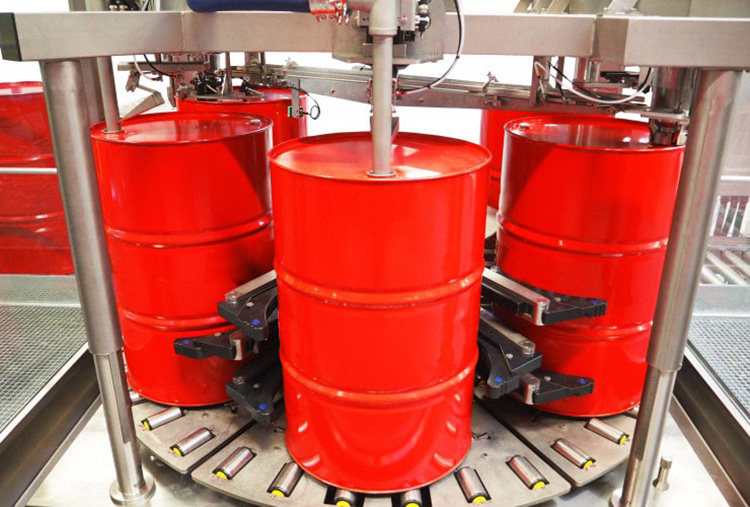
Automatic liquid filling line Related Products

